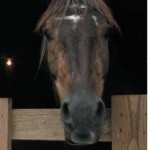 Nothing is more disconcerting to horse owners than a horse behavior that is both repetitive and harmful. A stall vice is one such behavior; it is a repetitive bad habit a horse can acquire for a variety of reasons. Stall vices can affect your horse’s dependability and/or health, and once a vice is set, it is a very difficult habit to break. Boredom is by far the most common cause of vices, and the most common vice is cribbing.
Nothing is more disconcerting to horse owners than a horse behavior that is both repetitive and harmful. A stall vice is one such behavior; it is a repetitive bad habit a horse can acquire for a variety of reasons. Stall vices can affect your horse’s dependability and/or health, and once a vice is set, it is a very difficult habit to break. Boredom is by far the most common cause of vices, and the most common vice is cribbing.
Cribbing may arise for many reasons:
•Boredom
•Stress
•Nervousness
•Curiosity
•Excessive energy
•Nutritional deficiencies
What is cribbing?
Cribbing occurs when the horse grabs on to something solid and wooden (like a fence post or barn door), sets his incisors into it, arches his neck, and pulls backwards, sucking air through his teeth into his stomach. This creates a pleasurable “head rush” for the horse that can become addictive. A cribbing horse can experience a variety of problems resulting from the vice, ranging from digestive conditions to severe wear of the upper incisor teeth. Cribbing can also cause malocclusions, an undesirable positioning of the upper and lower teeth when the jaw is closed.
A horse can become so addicted to this behavior that it would rather perform the cribbing action than eat. Many severe cribbers lose weight, which can further affect health and/or performance.
Interestingly, horses that are stalled together may tend to exhibit many of the same vices, including cribbing. This is believed to be caused by exposure to the same stressors in the environment, rather than being a learned behavior.
It can be extremely difficult to stop this behavior once it is established, and although there are cures, they can be expensive, such as covering all wood surfaces with rounded metal edges. Other methods for halting cribbing activity include subjecting your horse to expensive surgery or harsh mechanical cribbing collars or straps. In short, it is much easier to prevent the behavior than to correct it after it is set. “Cures” such as cribbing straps, shock collars, or surgery are considered unkind and do not address the underlying factors that cause the behavior.
Prevention
The best way to prevent cribbing is to avoid confining your horses for long periods of time. Turn out your horses more often to give them more freedom and opportunities to burn off excess energy. Do whatever you can to optimize your pasture land for your horse. Another way to tackle your horse’s excess energy is through a feed change. Many owners opt to feed more roughage instead of grain; their horse still gets good vitamins and minerals, but not the excess carbohydrate energy to burn (some studies have shown that a horse fed a high-grain diet, especially a premium grain, has more energy to burn).
Relieve Stress
Whenever possible, reduce stress by allowing your horse (a social animal) interaction with other horses in the stable. Owners report that even having a goat, or a rooster, for a horse to interact with, helps provide a social outlet that can relieve the stress of confinement.
Regular exercise will also help reduce stress and provide sensory stimulation. Ride him in different environments, so his brain can be even more stimulated. Enroll your horse in a training session. Provide stimulation through toys, like Pony Pops or a Jolly Ball to play with and combat boredom. Play the radio when your horse is stalled. Other owners rely on massage therapy to reduce their horse’s stress.
Deter cribbing through avoidance
Make the surfaces your horse cribs upon less desirable. Coat the surface with cayenne pepper, or an anti-chew spray. These products provide a very strong taste deterrent that may stop your horse from grabbing and cribbing objects such as stall doors. Some owners go through the expense of installing rounded metal edges on cribbing surfaces to deter cribbing.
Cribbing is an unfortunate, and usually preventable, habit. Instead of scrambling for a cure after it is long established, be proactive in prevention. Give your horses plenty of exercise outside the stall in good pasture land, plenty of environmental stimulation, socialization with other horses or animals, a healthy diet void of nutritional gaps, and your personal affection and attention.
Drs. Foster & Smith Educational Staff